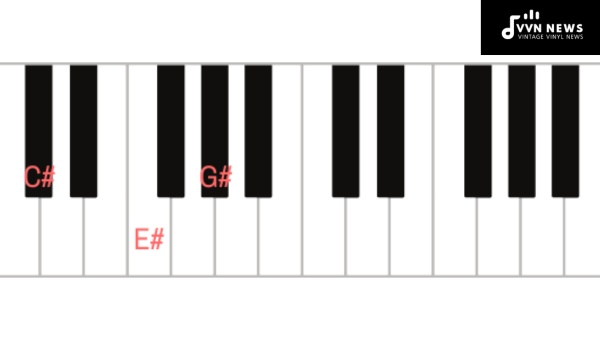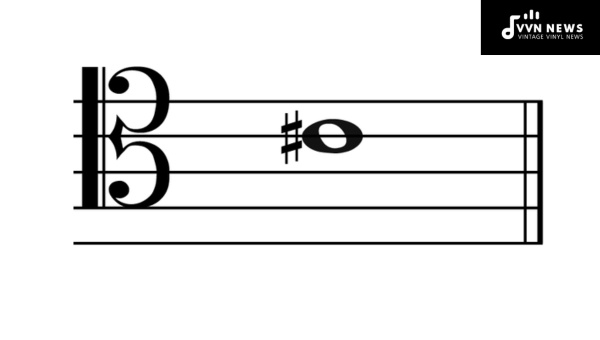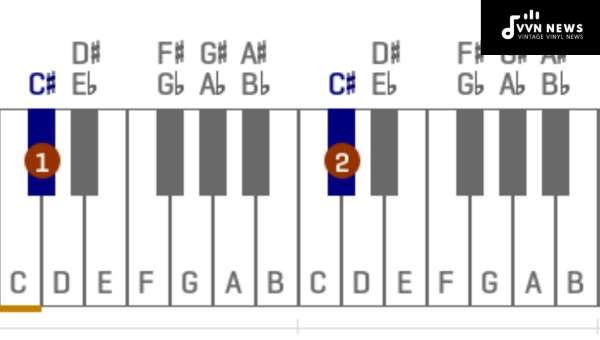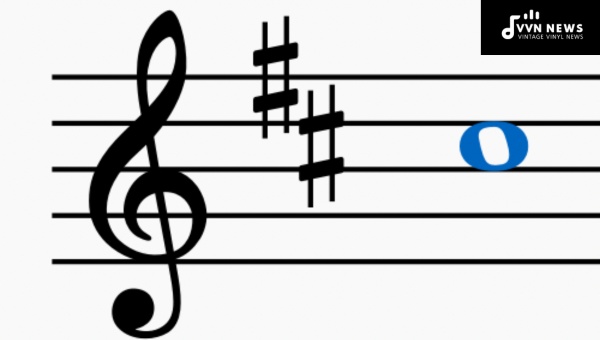Have you ever come across a piece of music that features the C sharp music note and wondered about its significance?
This particular note, often abbreviated as C#, holds a unique place on the musical scale and carries with it a richness that can truly elevate a composition.
Whether you’re ticking away at piano keys or strumming a guitar, understanding the C sharp and its role in music theory is essential for any budding musician.
Think of the musical alphabet as a puzzle; every note is a crucial piece, including the C sharp.
It’s like unlocking a new level of sound dynamics, one that can add depth and expression to your pieces.
As we delve deeper into what makes this note so special, I’ll guide you through its characteristics, how to find it on various instruments, and ways to incorporate it effectively into your own music—allowing you to appreciate its intricate beauty firsthand.
C Sharp Note on the Staff
On a music staff, the note C sharp typically occupies the space just above the C note line.
This placement is universal whether you’re reading treble, bass, or another clef.
C sharp is denoted by placing a sharp sign (♯) right before a C note. It’s vital in differentiating it from its natural counterpart.
Recognizing this symbol is key to understanding and playing C sharp correctly.
It might seem minor, but this accidental elevates the pitch of C natural by a half step or semitone, producing a distinct sound that’s essential in various musical styles and contexts.
C Sharp Note’s Position on Piano and Keyboard

The C sharp note (C#) is an essential semitone that lies between the white keys of C and D on a piano or keyboard.
In musical notation, a sharp symbol (♯) raises the pitch of any note by a half step, which is why you will find the C# on the immediate black key to the right of middle C.
On an 88-key standard piano, there are as many as nine C# notes to discover, starting from C#1 (the first black key in the set of two) up to C#8.
The most central of these—the one closest to the pianist—is typically referred to as middle C#, which resides near the middle of the keyboard.
Middle C#, or C#4, is often used as a reference point for tuning other instruments.
Here’s a quick guide on how to locate it:
- Identify middle C (the white key immediately to the left of the group of two black keys near your piano’s center).
- Look directly to its right; that black key is middle C#.
- Moving in either direction along the keyboard, every subsequent group of two black keys begins with another C#.
Remembering this pattern will help you quickly recognize all instances of C sharp across your instrument—letting you navigate your musical journey with confidence and ease.
Also Read: C Sharp Major Pentatonic Scale [Crisp & Clear Tones For Your Music]
Possible Accidentals for a C Sharp Note
As you dive into the intricacies of musical notation, you’ll come across various signs known as accidentals.
These symbols are essential for altering the pitch of notes either up or down.
When it comes to a C sharp note, there are a few accidentals that might come into play, especially considering its position as a half-step higher than C natural.
Consider the C natural note, which resides comfortably in the middle of the piano keyboard.
By adding a sharp (#) sign before this note, we enhance its pitch to produce C sharp. But what happens when we add different accidentals?
- Natural (♮): This symbol cancels any previous accidentals on the same note within a measure or line; it’s not commonly placed before a C#, but it can be used, for example, if the music piece changes and requires you to return to playing C natural.
- Double Sharp (????): While not as common, this accidental raises the pitch by two half-steps. When applied to a C#, it leads us to D natural – though written as Cx (C double sharp), an intriguing step that adds complexity to your musical landscape.
- Flat (♭): Normally, flats lower the pitch of a note by one half-step. In cases where a piece has been transcribed and originally had Db (D flat), which is enharmonically equivalent to C#, altering it back would involve applying a natural sign rather than using a flat.
Understanding these variations broadens your musical vocabulary and allows you to navigate confidently through sheets peppered with sharps, flats, and naturals alike.
The C sharp note, with its possible accidentals, truly showcases how dynamic and multidimensional music notation can be when explored in depth.
Also Read: G Sharp Minor Pentatonic Scale [Add Dimension To Your Music]
C Sharp Note in Different Musical Clefs

Music is a language with its own set of symbols and notations, and the position of notes can vary depending on the clef used.
The C sharp note, although the same pitch, is represented differently across various clefs. Let’s explore how C# (C sharp) finds its place in each.
Treble Clef
In the treble clef, C# typically lies on the third line from the bottom, between the B line and the D space above it.
When you look at sheet music, you’ll need to identify where a sharp (#) symbol has been placed on that third line.
Once you’ve located this, it’s your cue that all notes on this line should be played as C sharp.
Bass Clef
Moving to the bass clef, C sharp drops down dramatically in position—specifically to the second space from above.
This lower clef mandates a whole new perspective on where notes sit visually, but once again, if a sharp sign is plastered there, those notes march to the beat of C sharp.
Alto Clef
Now let’s talk about the alto clef, which isn’t as commonly utilized but still vital for certain instruments like the viola.
Here, C# dances whimsically onto the first space below middle C. It takes practice to get used to alto notation after working with more common clefs but learning it can expand your musical repertoire significantly.
Tenor Clef
The sister of the alto is the tenor clef—another medium-rare find. In tenor, you’ll catch C sharp lounging just above middle C in terms of pitch; visually, it sits directly on that mellow middle line of the staff.
Mezzo-Soprano Clef
Historically pertinent yet scarce today is mezzo-soprano clef. Should you encounter such ancient manuscripts or specialized modern pieces that call upon this relic, know that your C# will bloom right below middle C.
Soprano Clef
Similarly antique is the soprano clef with an even higher placement for our dear note—being two lines above middle C—the way birds perch high up on power lines.
Also Read: F Sharp Minor Pentatonic Scale [How To Use In Your Compositions]
Baritone Clef
Last and most bass-heavy we have a baritone clef; here our melodic nomad takes its spot just like in soprano but down under near bass territory—one flatlined step above F.
Each musical clef carves out its own pathway for notes to thrive and communicate its auditory essence.
For instrumentalists who aspire to fluency across these diverse musical dialects; grasping how each one serves up a delectable note like C sharp is an essential seasoning for their artistry toolkit.
Popular Scales with C Sharp as the Starting Note
When I explore the realm of scales, C sharp serves as a foundation for several captivating sequences of notes.
The C sharp major scale, for example, is a heptatonic scale comprised entirely of sharp notes.
Its sequence runs C#, D#, E#, F#, G#, A#, and B# before ascending back to the upper octave’s C#.
This bright-sounding scale is rich and sonorous, offering a sense of resolve and completeness that’s both satisfying and pleasantly harmonic.
Another scale that begins with C sharp is the C# minor. This one includes the notes C#, D#, E, F#, G#, A, and B. Its tonality is more somber and emotional compared to its major counterpart, providing a profound backdrop for evocative melodies.
For those looking into modal scales, the C# Phrygian could be an interesting choice.
It starts on C# but follows the pattern of a Phrygian mode, giving it an exotic flavor often associated with Spanish music.
If you’re curious about jazz or blues, unlocking the secrets of C# pentatonic scales—both major and minor—is essential.
These five-note scales cut through complexity to deliver soulful sounds and are incredibly versatile in improvisation.
What Modes are Initiated by the C Sharp Note?

In the realm of music theory, the C sharp note serves as the starting point for various modes, each bringing its own flavor and mood to pieces.
For those who may not be familiar, a mode is essentially a type of musical scale characterized by a specific pattern of intervals between consecutive notes.
The Ionian Mode
The C sharp Ionian mode, or the C# Major scale, is quite possibly one of the most utilized modes in Western music.
Its series of whole and half steps generate a sound that feels complete and resolute—ideal for establishing a strong tonal foundation.
The Dorian Mode
Then there’s the C sharp Dorian mode, which begins on the note C# of course.
This mode carries a jazzy feel to it—a minor third with a major sixth gives it an edge that can add complexity to your tunes.
The Phrygian Mode
Initiating on C sharp, the Phrygian mode introduces an exotic twist with its semitone interval at the very beginning.
This can inject drama or tension into your music, giving you that mystical vibe often heard in film scores.
The Lydian Mode
Another energizing mode originating from C# is Lydian. It stands out with a raised fourth interval, creating an almost dreamy and ethereal soundscape. Bold yet comforting at once, it opens doors to creative composition.
Also Read: D Sharp Minor Pentatonic Scale [Inject Drama Into Your Melodies]
The Mixolydian Mode
For a more bluesy or rock ‘n’ roll sound, we turn to the C sharp Mixolydian mode. The lowered seventh interval adds grit and soul—perfect for conveying emotion.
The Aeolian Mode
Then we have Aeolian, better known as the natural minor scale when it starts on A. However, when we begin this mode on C#, it becomes C# minor, delivering that quintessential melancholic voice we often associate with minor keys.
The Locrian Mode
Lastly is Locrian stepping forward from C#. Known for its diminished fifth and haunting aura, this one demands attention from musicians looking to experiment with tension in their compositions.
By plumbing these modes initiated by C sharp, you open up a world of expression in your musical undertakings. Play around with them; feel their distinct vibes under your fingers and let them inspire unique harmonies and melodies in your next practice session or songwriting venture.
The Frequency Spectrum of the C Sharp Music Note
In music, each note resonates at a unique frequency, vibrating to cast a specific sonic signature.
The C sharp note, strikingly, hums on a frequency of approximately 277.18 Hz when tuned to standard A440 tuning.
This is in the context of C♯4, often referred to as “Middle C♯” on the piano. Frequencies double with each octave increase, thus C♯5 will vibrate around 554.36 Hz, and so on.
Understanding this frequency spectrum is pivotal for various musical endeavors—from tuning instruments to designing sound systems.
Recognizing these vibrations allows you to weave the C sharp note into your compositions seamlessly, producing rich and resonant pieces that captivate the listener’s ear.
Also Read: G Sharp Diminished Triad [Explore Unique Guitar Chords]
FAQs About C Sharp Music Note
What does the C# note represent in music notation?
C# is the symbol for C sharp, a half step higher than middle C on the musical scale.
How do you play a C# note on guitar?
To play a C# on the guitar, press down on the first fret of the B string or the sixth fret of the G string.
Can you explain the difference between C# and Db?
C# and Db are enharmonic equivalents, meaning they sound identical but are written differently based on the musical context.
What instruments frequently use C sharp in their standard tuning?
Instruments like guitars, pianos, and violins commonly use C sharp in their standard tuning due to its prevalence in various keys and scales.
Are there songs that revolve around the key of C sharp?
Yes, songs across genres—from classical to pop—often feature melodies and chords centered around the key of C#.
Conclusion
The C sharp music note is a pivotal element in the world of music, offering a stepping stone to a symphony of melodic possibilities.
Whether it serves as a sharp alternative to C natural or acts as the root in intricate scales and chords, C# is both versatile and profound.
With its place on the staff and instruments like piano and guitar, grasping its essence enriches your musical journey.
Embrace C sharp’s unique harmonic flavor and let it enhance your creative expression, making your compositions resonate with listeners everywhere.








